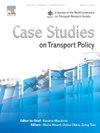Optimization of transport sustainability index to conserve resources: A case study of Delhi, India
IF 2.4
Q3 TRANSPORTATION
引用次数: 0
Abstract
The objective of the study is to propose a methodology for optimization of Transport Sustainability Index (TSI) of National Capital Territory (NCT) of Delhi since maximum value of TSI i.e. 1.0 will occur when all the sustainability indicators attain their extremum values simultaneously, which is highly improbable. TSI is estimated using 29 most appropriate transport sustainability indicators under four pillars of sustainability, viz. environmental, social, economic, and technological. Optimization of TSI involves following steps, viz. identification of three independent variables, i.e. fuel consumption (X1), registered vehicles (X2) and population (X3) which influence all the indicators, data collection in respect of indicators and influencing variables for 30-year time period (from year 2000 to 2030), evolution of regression equations between indicators and influencing variables, and formulation of TSI as a multi-variate non-linear expression in terms of influencing variables, which is used for optimization. The generalized reduced gradient non-linear programming optimization technique is used to solve for the optimum values of influencing variables (X1opt, X2opt, X3opt) as 0.0988, 0.4709 & 0.0 respectively and optimum value of TSI (TSIopt) as 0.71, which is 25% higher than the TSI of 0.59 for the year 2023–24. The knowledge of optimum value of TSI would help the city transport policy planners to allocate, only that much quantum of infrastructural and financial resources so as to reach optimum rather than extremum values, which leads to potential savings or conservation of resources. An overall notional savings of 58% has been estimated by the study.
优化交通可持续性指数以节约资源:印度德里案例研究
本研究的目的是提出一种优化德里国家首都区(NCT)交通可持续性指数(TSI)的方法,因为当所有可持续性指标同时达到极值时,TSI 的最大值即 1.0 将出现,而这是极不可能的。TSI 是根据可持续发展的四大支柱,即环境、社会、经济和技术,使用 29 个最合适的交通可持续发展指标进行估算的。TSI 的优化包括以下步骤:确定影响所有指标的三个自变量,即燃料消耗量(X1)、注册车辆数(X2)和人口数(X3);收集 30 年期间(从 2000 年到 2030 年)指标和影响变量的数据;建立指标和影响变量之间的回归方程;将 TSI 表述为影响变量的多变量非线性表达式,用于优化。利用广义梯度非线性编程优化技术,求解出影响变量的最优值(X1opt、X2opt、X3opt)分别为 0.0988、0.4709 & 0.0,TSI 的最优值(TSIopt)为 0.71,比 2023-24 年的 TSI 值 0.59 高出 25%。对 TSI 最佳值的了解将有助于城市交通政策规划者仅分配相应数量的基础设施和财政资源,以达到最佳而非极值,从而节省或保护潜在资源。研究估计,理论上可节省 58%的资源。
本文章由计算机程序翻译,如有差异,请以英文原文为准。
求助全文
约1分钟内获得全文
求助全文

 求助内容:
求助内容: 应助结果提醒方式:
应助结果提醒方式:


